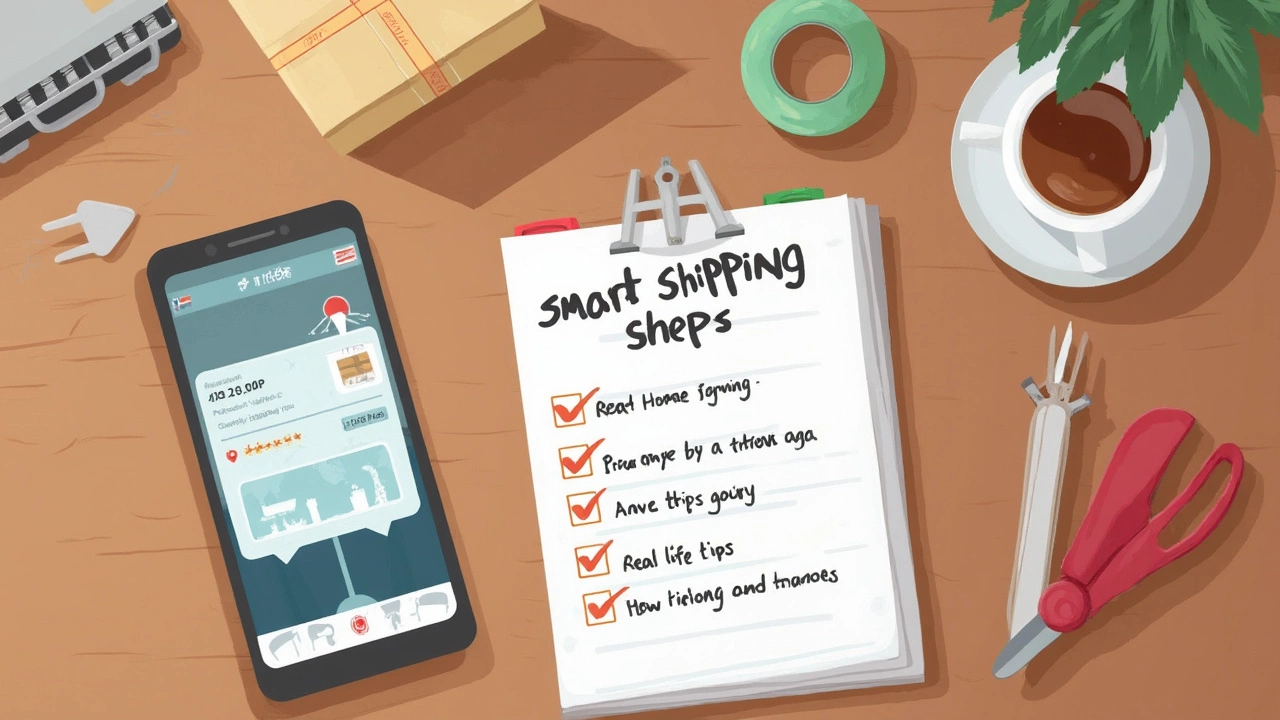If you've ever stood in front of your closet, clutching a birthday gift and wondering how to get it across the country—yeah, you're not alone. Using a courier service is actually a lot simpler than most people think. The tricky part? Most folks just don't know where to start.
First off: every courier, from the big names like FedEx and DHL to local bike messengers, wants the same thing—you hand over your parcel, you pay, they ship it safely. That’s the whole deal. But here’s the kicker: the details are what matter. Knowing how to pack your stuff, fill out the forms, and track the delivery can save real time, money, and headaches.
The moment you figure out the basics, everything starts falling into place. You get better rates, you dodge common mistakes, and your packages stop “mysteriously vanishing” on the way to Grandma’s house. Most hiccups come from people guessing what to do instead of following three easy steps: pick the right courier, pack your item right, and double check the address like your life depends on it. Oh, and don’t toss out that tracking number—ever.
- Picking the Right Courier Service
- Packing Your Item Properly
- Booking and Labelling the Shipment
- Paying and Tracking
- Common Mistakes and Quick Fixes
Picking the Right Courier Service
Alright, you’ve got stuff to send, but the choices feel endless. Big names like FedEx, UPS, DHL, and the regular postal service are everywhere, but smaller local couriers are sometimes faster (and cheaper) for quick city runs. So how do you actually pick? It’s about speed, size, location, and—let’s be real—your wallet.
The most important thing you need to nail down first: courier service ratings on speed and reliability. According to Statista’s 2024 shipping survey, 72% of people now expect their packages to arrive in two days or less. Couriers know this, so many offer same-day, next-day, or standard options. If you’re in a rush, overnight shipping isn’t just for businesses—plenty of regular folks use it for forgotten birthdays and last-minute documents (trust me, I’ve been there).
"People often think cheap is best, but reliability saves you way more in the long run. Lost or delayed packages can cost a business its reputation," says Lori Hopkins, Logistics Lead at ParcelPath.
So, here’s what you actually want to look at when picking a courier:
- Delivery speed: Need it there tonight or is next week fine?
- Destination coverage: Does the courier actually reach your recipient? Small-town deliveries sometimes trip up the bigger companies.
- Pricing and size limits: Prices jump fast for heavier or odd-shaped stuff. Check their online calculators before you commit.
- Tracking options: Always pick a service with tracking—even if it costs a little extra. You don’t want to play detective later.
- Package insurance: If it matters to you, pay for insurance. Most basic rates cover very little if things break or vanish.
Here’s a quick glance at what the main couriers offer for standard domestic shipping (as of 2025):
| Courier | Standard Delivery | Same-Day Option | Tracking | Insurance Included |
|---|---|---|---|---|
| FedEx | 1-5 days | Yes (in select cities) | Yes | $100 |
| UPS | 1-5 days | Yes (in metro areas) | Yes | $100 |
| DHL | 2-7 days | Limited | Yes | $50 |
| USPS | 2-8 days | No | Limited | $50 |
| Local Courier | Same day | Yes | Yes | Varies |
If you’re not sure, check the courier’s reputation online—reviews will tell you more than slick ads ever can. And don’t forget: for super urgent stuff or huge boxes, calling and asking questions gets you real answers quickly. The best service isn’t always the one you’ve heard of most; it’s the one that fits today’s needs without busting your budget.
Packing Your Item Properly
Packing sounds easy until your mug shows up at its new home looking like a thousand-piece puzzle. The trick isn’t fancy wrapping—it's all about using the right stuff, the right way. Couriers reject more parcels than you'd think just because they're packaged badly. That's why this step matters so much in the courier service process.
First, always go for a sturdy box. If the box has old labels or is ripped, skip it. Most couriers prefer a brand-new or clean box because it holds up better on conveyer belts and long rides. If your item has sharp edges or is breakable, add a layer of bubble wrap or at least some old newspaper for cushion. And don’t forget to fill empty spaces inside the box. This isn’t just so your stuff looks neat—when things shake around, they break. A little packing material, like crumpled paper or foam peanuts, goes a long way.
Sealing sounds obvious, but lots of people mess it up. Ditch the masking tape or scotch tape. Use strong packing tape—at least two inches wide—and make sure all openings and flaps are flat and covered. If you're sending liquids or anything that could leak, double-bag and tape it shut before boxing it up.
- Always write the address clearly, both on a shipping label and directly on the box with a marker (yup, backup counts).
- Don’t pack restricted items—like batteries or perfumes—without checking the courier’s rules. You might be surprised at what gets held up or sent back.
- If your parcel needs to stay upright, mark it with "This Side Up" and maybe even draw an arrow, just in case.
A quick real-world tip: Take a photo of your package before you hand it over. If there’s ever a claim or dispute, that photo can save the day. Packing right isn’t about looks—it’s about getting your stuff to the end point in one piece, no drama.

Booking and Labelling the Shipment
Once your item is packed, it’s time to actually get it on its way. Here’s where the magic happens—booking your shipment and making sure it’s labelled so the courier knows exactly what to do with it. This is a big moment because it sets the stage for your courier service to do its job right.
You usually have two options for booking: walk into a courier shop or do it online. Most big companies, like FedEx or DHL, push you toward online booking because it’s faster and you can see all the options right away. Online, you’ll need to fill out a form with things like the package size, weight, value, destination, and what’s inside. Some couriers have handy calculators to help you pick the best service for your budget and deadline.
- Double check the delivery address. Typos are the #1 reason packages end up in the wrong place. If you’re sending internationally, make sure to include ZIP/Post Codes and sometimes even the recipient’s phone number.
- If your item’s valuable or fragile, look for options to add insurance. Couriers usually offer this during the booking step, and for a lot less money than you might expect. It’s worth it for peace of mind.
Labelling is just as important as booking. After you fill in your info online, you’ll usually get a shipping label as a PDF—print this out and stick it squarely on the top of your box, not on the tape or seams. Most labels include a barcode, which couriers scan every step of the way to keep tracking accurate. If you book at a shop, the employee will handle this for you.
If you’re reusing a box, peel off old labels and barcodes—couriers use automated machines to scan boxes, and extra stickers can confuse the system, leading to delays.
Quick tip: Some couriers let you schedule pickups at your home or work, so you don’t even have to step outside. Just make sure your package is ready and labelled before they arrive, or you risk missing your slot.
Paying and Tracking
Paying for your shipment is about as simple as buying groceries these days. Most couriers accept cards, digital wallets like Apple Pay or Google Pay, and even cash if you’re dropping the package off in person. Prices usually depend on how heavy or big your package is, how far it’s going, and how fast you want it there. If you’re shipping something super urgent, expect to pay more—same-day delivery can cost double or even triple standard rates.
A ton of people overpay because they don’t check the size or weight of what they’re sending. Got kitchen scales at home? Weigh your parcel first and grab a tape measure. Most companies have online calculators on their sites, so you can get an exact price before you even leave your house. Here’s a quick look at what different services might charge on the same package:
| Service | Delivery Speed | Cost (Average, small parcel 2kg, domestic) |
|---|---|---|
| FedEx | Overnight | $35 |
| DHL | 2-3 Days | $22 |
| UPS | Standard | $15 |
| Local Courier | Same Day (in city) | $10-$20 |
Once you pay, don’t walk off without your tracking number. This little code is gold. It’s how you follow your parcel’s journey online, so you know exactly where it is. Stuff gets lost way less these days—97% of packages shipped with major couriers make it on time, according to a 2024 Statista report—but mistakes happen. If anything goes sideways, tracking is your ticket to a quick solution.
Most companies offer updates via email, SMS, or right in their apps. You just plug your tracking code into their website and bam, the latest info pops up. If you’re sending something valuable, ask for delivery confirmation or a signature on arrival. That’s the best insurance in case your package goes missing or the recipient claims they never got it.
In short, pay attention when you handle the payment and never ignore the tracking part. That way, you stay in control from drop-off until delivery, and your shipping nerves can take a back seat.

Common Mistakes and Quick Fixes
Messing up with a courier service often boils down to small, easy-to-avoid mistakes. The good news? Almost every issue has a simple fix. Let’s walk through some of the most common blunders people make when sending packages—and exactly what you should do instead.
- Wrong or incomplete address: Seems basic, but it’s the number one reason packages go missing. Always double (and triple) check spellings, apartment numbers, and postal codes. If the address is off by even one character, your package could end up in another city.
- Poor packing:
- Too many people toss their item in a box with zero padding. Use bubble wrap or scrunched-up paper, especially for anything even slightly fragile. Some courier services deny damage claims if they see sloppy packing.
- Label confusion:
- Never stick packing tape over barcodes or tracking stickers. This messes up the scanner and can delay delivery by days.
- Forgetting to keep the tracking number:
- Without it, you’re mostly out of luck if something goes wrong. Snap a photo or email it to yourself, just in case.
- Ignoring the weight and size limits:
- Couriers charge extra fees if your parcel is bigger or heavier than you claimed. Oversize charges aren’t negotiable, and you don’t want a surprise bill.
Here’s what these slip-ups can cost you, straight from a recent industry survey:
| Mistake | Potential Consequence | Extra Cost ($) |
|---|---|---|
| Wrong Address | Lost Parcel, Re-delivery | 10–20 (redelivery fee) |
| Poor Packing | Damaged Item | Item value, claim denied |
| Oversize/Overweight | Extra Handling Fee | 10–50 per parcel |
| Lost Tracking Number | No Way To Track/Claim | Replacement shipping |
If you want to keep your courier service experience smooth, just treat package details like you’d treat online banking passwords: pay attention and don’t rush. If you realize you’ve made a mistake after sending, call the customer service hotline right away—most couriers can fix things if you catch the issue fast. Never assume a problem will magically work itself out, especially when it comes to these tiny but costly slip-ups.





